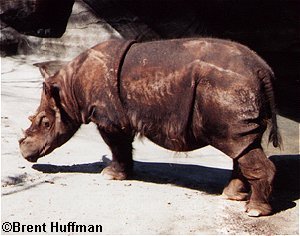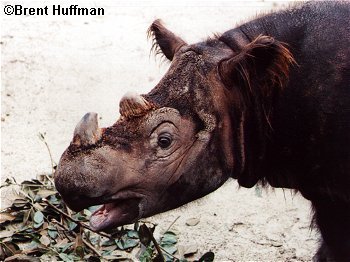Dicerorhinus sumatrensis
 SPECIAL NEWS
SPECIAL NEWS
On September 13th 2001, the first Sumatran Rhino to be born in captibity in 112 years arrived at the Cinncinnati Zoo in the United States. The little male was born at 11:23 am and his mother was attentive to him. For more information see the Zoos website.
During the mid 19th century more than a million members of this species roamed South East Asia. Today, thanks to habitat destruction and poaching, the numbers have dropped to fewer than 300 in three seperate populations. They can only be found on the island of Sumatra, the Malayan Peninsula and the island of Borneo.
Although the Javan Rhinos have fewer numbers, theSumatran can be considered to be more endangered. The Javan individuals are well protected whilst the Sumatran populations are still vulnerable to both poaching and habitat desruction. To make matters worse for the species, a genetic study conducted in 1992 determined that the Bornean population was genetically distinct from its cousins on Sumatra and Malaysia.
This meant that the two groups should not be interbred as the Bornean individuals, which it is thought have been seperated the longest, have evolved to meet unknown enviromental characteristics of Borneo.
 In 1999 there were only 17 individuals in captivity, 5 males and 12 females, in four managed facilities. Cincinnati Zoo have three animals, a male and 2 females. The rest are held in native habitats at the Sungai Dusun Sumatran Rhino Conservation Centre in Peninsula Malaysia; the Sumatran Rhino Sanctuary in Way Kambos National Park, Sumatra, Indonesia; and Sepilok Wildlife Reserve in Sabah, Malaysia on the Island of Borneo.
In 1999 there were only 17 individuals in captivity, 5 males and 12 females, in four managed facilities. Cincinnati Zoo have three animals, a male and 2 females. The rest are held in native habitats at the Sungai Dusun Sumatran Rhino Conservation Centre in Peninsula Malaysia; the Sumatran Rhino Sanctuary in Way Kambos National Park, Sumatra, Indonesia; and Sepilok Wildlife Reserve in Sabah, Malaysia on the Island of Borneo.
Captive Breeding of this species does not seem a likely option. Between 1984 and 1994 forty indiviuals were captured and sent to various zoos in Europe and North America to establish a captive breeding program. It failed dismally. It was extremly expensive and many of the animals died. Nor did it achieve its aim, no animal has been born in captivity since 1889! Hopes are high that this might soon change. An eleven year old female at Cincinnati Zoo, called Emi, is now 10 months through her pregnancy. Emi has been pregnant six times but this is the first time she has been able to carry past her third month.
With an estimated gestation time of between 14 and 16 months, Emi could give birth as early as August but more likely in October. If she carries through full term she will give birth to the first Sumatran Rhino in captivity in 112 years.
Obviously the birth of a calf will not save the species but is hoped that the knowledge will help in conservation work for the species.
More information on the Sumatran Rhino can be found at Brent Huffmans Homepage on ungulate animals